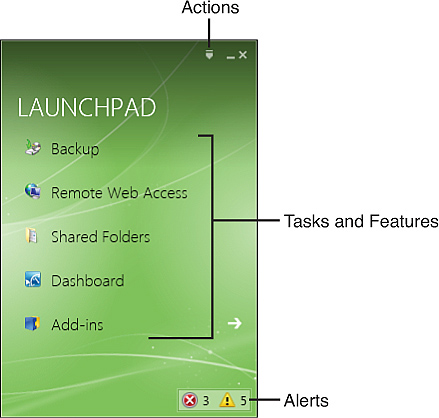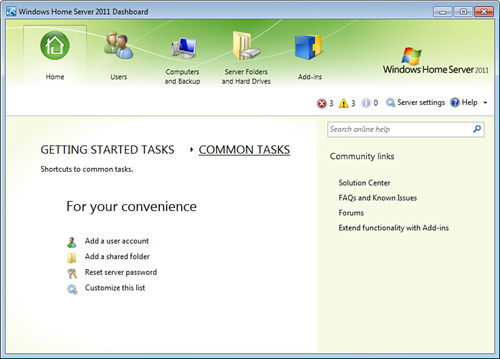Running the Windows Home Server Launchpad
The
Launchpad is a client-side tool that’s new with Windows Home Server
2011, and it’s designed to give you easy access to common Windows Home
Server tasks and features. On most systems, Launchpad starts
automatically, but if it’s not already started on your computer, you
have two ways to make it so:
- Select Start, All Programs, Windows Home Server 2011, Windows Home Server 2011 Launchpad.
- Display the Launchpad icon in the notification area and then double-click the icon.
The first time you do this,
you’re prompted to enter your Windows Home Server username and password.
If you don’t want to type your username each time, activate the
Remember Me on This Computer check box. (If you don’t see this check
box, click Options.) If you want to sign in automatically (and if other
people can’t access your computer), you can also activate the Remember
My Password check box.
When you’re ready, press Enter. Figure 1 shows the Launchpad window that appears.

There are three sections of the Launchpad window to note:
Actions. Click this icon (pointed out in Figure 4.1) to access the Launchpad settings or to sign out from Launchpad.
Tasks and Features.
This area gives you one-click access to five common Windows Home Server
tasks and features: Backup (which enables you to run a manual backup
right away); Remote Web Access; Shared Folders; Dashboard; and Add-ins
(which you only see if you have any client add-ins installed).
Alerts. This area (see Figure 1) lets you know if there are any health alerts that you need to take care of.
The alerts that appear in
Launchpad are controlled by the scope, which defines which alerts you
see. There are three possible scopes:
None— This scope means that you don’t see alerts. This is useful if you’re configuring Launchpad for a novice user.
Local Only—
This scope means that you only see alerts that apply to your computer.
This is useful if you’re configuring Launchpad for intermediate users
who may be able to either solve the problem or, more likely, know to
notify you when an alert comes up.
Local and Network—
This scope means that you see not only alerts for the client computer,
but any other health alerts generated by Windows Home Server or by other
clients on the network. This is useful for anyone who is administering
Windows Home Server.
To change the scope, follow these steps:
1. | Click the Actions icon, and then click Settings. The Launchpad Settings dialog box appears.
|
2. | In the Scope of Alerts to be Presented section, click None, Local Only, or Local and Network.
|
3. | Click OK to put the new setting into effect. |
Running the Windows Home Server Dashboard
Most of the Windows Home Server
configuration chores are easily accomplished via the Windows Home
Server Dashboard application (which replaces the Console application
from a previous version of Windows Home Server). To ensure that you can
always access this program easily, here’s a list of the various methods
you can use to launch it:
- On the Windows Home Server machine, select Start, All Programs, Windows Home Server 2011, Dashboard.
- On the Windows Home Server machine, double-click the Dashboard desktop icon.
- On a client machine, select Start, All Programs, Windows Home Server 2011, Windows Home Server 2011 Dashboard.
- On a client machine, open Launchpad and then click Dashboard.
- On the client machine, right-click the Launchpad icon in the notification area and then click Open Dashboard.
- On the server, select Start, Run (or press Windows Logo+R) to open the Run dialog box, type %ProgramFiles%\Windows Server\Bin\Dashboard.exe, and then click OK.
- On a client, select Start, Run (or press Windows Logo+R) to open the Run dialog box, type %ProgramFiles%\Windows Server\Bin\DashboardClient.exe, and then click OK.
If you’re running Windows Home Server Dashboard on a client, you see the logon screen shown in Figure 2.
Type the Windows Home Server password (that is, the password for
Windows Home Server’s Administrator account) in the text box, and then
press Enter or click the arrow. The Windows Home Server Dashboard appears, as shown in Figure 3.


Tip
If your computer is secure and
you want to avoid entering the Windows Home Server password each time,
display the logon screen, click Options, and then activate the Remember
My Password check box.
Note
If
you can’t recall the Windows Home Server password, click Options and
then click Password Hint to see some text that gives you a hint about
the password.